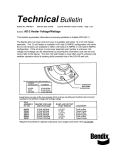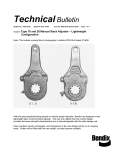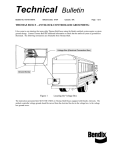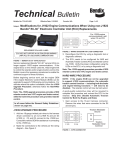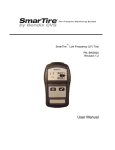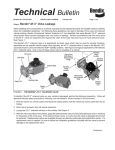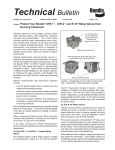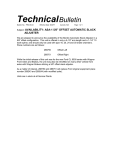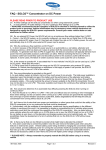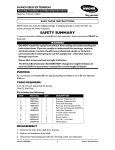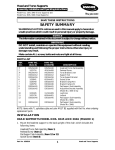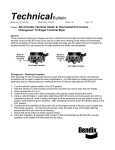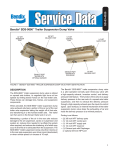Download BENDIX TCH-013-005 User's Manual
Transcript
Technical Bulletin Bulletin No: TCH-013-005 Subject: Effective Date: 6/26/00 Cancels: NA Page: 1 of 3 Wheel Speed Sensor Cable Chafing Bendix Commercial Vehicle Systems is reinforcing the importance of following proper installation and service guidelines for installing, routing and securing wheel speed sensors, sensor cables and wire harnesses for Bendix Antilock Braking Systems (ABS). Bendix has discovered that if wheel speed sensor cables are not properly routed and secured, the cable could rub on rotating components, causing damage which, in rare circumstances, could result in a temporary exhaust of brakes for a few seconds at low speeds. Although this issue has only been reported on a small number of straight trucks and buses, Bendix recommends that when servicing ABS, you ensure proper routing and securing of wheel speed sensor cables. Wheel Speed Sensor Cables Wheel speed sensor cables coming directly out of the wheel ends should be routed at least 1.5 inches away from moving components at all points and be properly secured to air lines and the axle to prevent excess cable slack and potential chafing damage. Ensure that the wheel speed sensor cables attached along the length of the service brake hoses are secured with tie wraps at intervals of approximately six (6) inches and are securely connected to the wiring harness. In addition the wheel speed sensor cable should be secured with a tie wrap three (3) inches from the sensor. Figure 1 - Photo of typical front wheel speed sensor cable installation (View from Top) Clamp Tie Wraps 6 inches apart Actuator Tie Wrap 3 inches from sensor 1.5 inch clearance at all points from wheel or rotating components with minimal slack in cable Tire Wire Harness Ensure all wiring routed along the frame rails is secured to frame members wherever possible. Secure every 12 inches throughout its length, preferably with non-metallic clamps or “Bow Tie” tie wraps. Route wires away from sharp corners, heat sources, and moving or rotating components. If a harness is installed through a frame member, grommets must be installed to prevent wire chafing. At all connectors, verify that the wires come out straight for a minimum of three (3) inches before any bends. Be sure all connector seals are fully engaged in the mating connector and secondary locks are snapped securely. Figure 2 – Diagram of typical rear sensor routing and wire harness installation Tie Wraps located every 12 inches on frame rail Tie Wrap 3 inches from sensor 1.5 inch clearance at all points from wheels or rotating components with minimal slack in cable Tie Wraps located every 6 inches along brake hose As with all maintenance procedures before working on any vehicle follow the Safety Precautions outlined below. IMPORTANT! PLEASE READ When working on or around a vehicle, the following general precautions should be observed. 1. Park the vehicle on a level surface, apply the parking brakes, and always block the wheels. 2. Stop the engine when working around the vehicle. 3. If the vehicle is equipped with air brakes, make certain to drain the air pressure from all reservoirs before beginning ANY work on the vehicle. 4. Following the vehicle manufacturer’s recommended procedures, deactivate the electrical system in a manner that removes all electrical power from the vehicle. 5. When working in the engine compartment the engine should be shut off. Where circumstances require that the engine be in operation, EXTREME CAUTION should be used to prevent personal injury resulting from contact with moving, rotating, leaking, heated, or electrically charged components. 6. Never connect or disconnect a hose or line containing pressure; it may whip. Never remove a component or plug unless you are certain all system pressure has been depleted. 7. Never exceed recommended pressures and always wear safety glasses. Page 2 of 3 8. Do not attempt to install, remove, disassemble or assemble a component until you have read and thoroughly understand the recommended procedures. Use only the proper tools and observe all precautions pertaining to use of those tools. 9. Use only genuine Bendix replacement parts, components, and kits. Replacement hardware, tubing, hose, fittings, etc. should be of equivalent size, type, and strength as original equipment and be designed specifically for such applications and systems. 10. Components with stripped threads or damaged parts should be replaced rather than repaired. Repairs requiring machining or welding should not be attempted unless specifically approved and stated by the vehicle or component manufacturer. 11. Prior to returning the vehicle to service, make certain all components and systems are restored to their proper operating condition. Bendix Commercial Vehicle Systems 901 Cleveland Street Elyria, OH 44035 440-329-9000 Page 3 of 3



